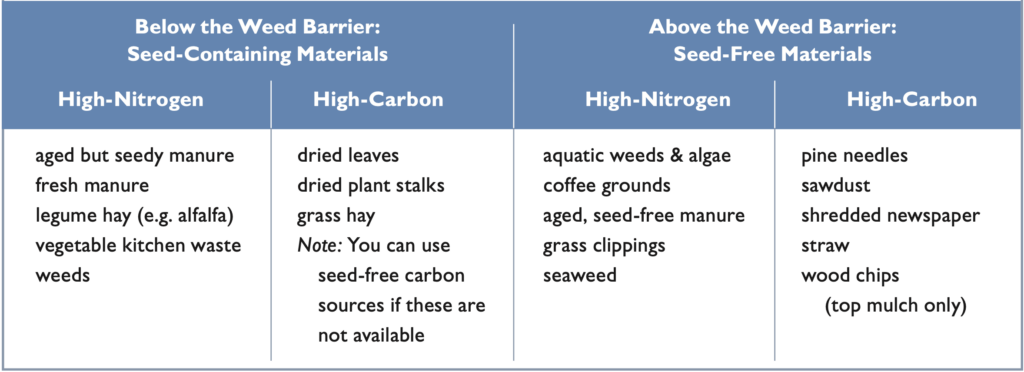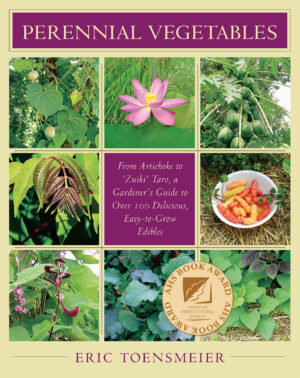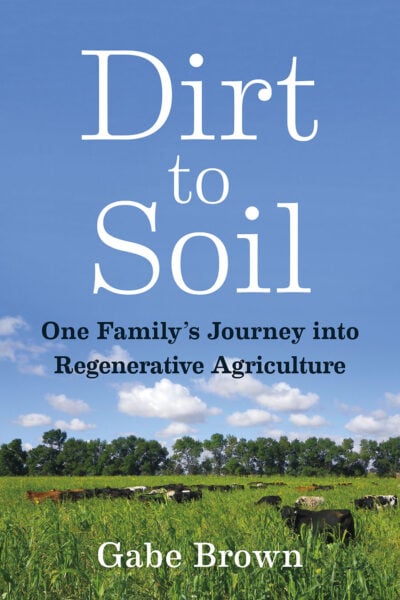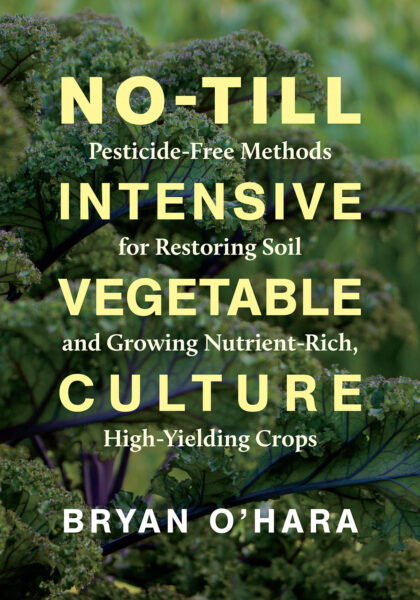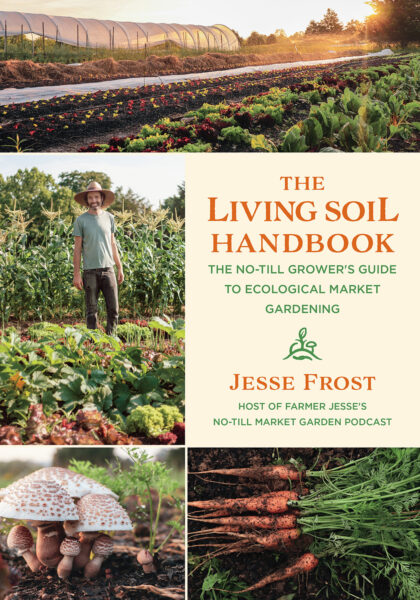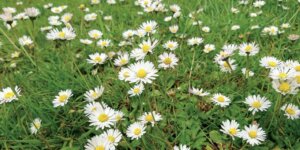9 Simple Steps to Sheet Mulching: Turn Barren Soil into Black Gold
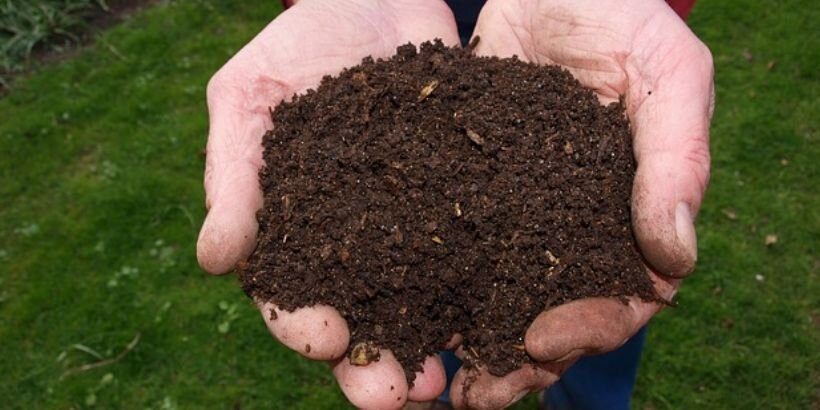
To turn a barren lot into a permaculture paradise, you’ve got to start from the ground up — and sheet mulching is an easy way to start. Here are some tips to help you strengthen your soil with the power of sheet mulching!
The following is an excerpt is from Perennial Vegetables by Eric Toensmeier. It has been adapted for the web.
(Cross section of a newly sheet-mulched garden bed showing layers of material. Illustration by Elayne Sears.)
What Is Sheet Mulching?
Sheet mulching combines soil improvement, weed removal, and long-term mulching in one fell swoop. This technique, also known as lasagna gardening, can build remarkable soils in just a few years.
There are several key components. First, a weed barrier like cardboard is laid down to smother weeds.
In theory (and quite often in practice) the cardboard decomposes after the weeds have all died and turned into compost.
The second ingredient is to add compost, or build a layered compost pile that will enrich your new garden bed.
The third step is to add a thick layer of mulch on top, to keep new weeds from getting established.
9 Simple Steps to Sheet Mulching
I have had great results with sheet mulching, although sometimes the first year is a bit rough on delicate species, until the raw materials break down.
You can use sheet mulching to turn lawns or weedy waste areas into gardens in just a few hours, or even to build soil from scratch inside built frames for raised beds.
Sheet mulch can range from just a few inches thick to 2 feet or more, depending on how bad your soil is and how much raw material you have available (it will cook down and settle quite a bit).
1. Mowing and Cutting
Mow or cut your lawn, weeds, or other vegetation right down to the ground.
2. Early Planting
Plant any crops that will require a large planting hole (including woody plants, perennials in large pots, and large transplants).
3. Soil Amendments
Add soil amendments (as determined by your soil test).
4. Water, Water, Water
Water the whole area thoroughly.
You are going to be putting a layer of cardboard or newspaper over it, and rain and irrigation won’t soak through very well until that weed barrier breaks down. Water also helps the decomposition process get going.
5. Spread Compost
If you have compost materials that may contain weed seeds (like fresh manure, leaves, or hay), spread them in layers on the ground.
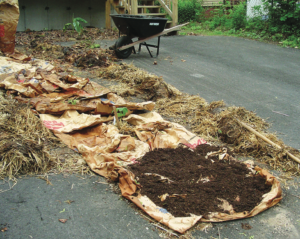
Addition of rotted leaves below thick paper bags as a weed barrier with a layer of compost and mulch on top—just a few hours of work.
Put a dry, carbonaceous layer of hay or shredded leaves below any manure layer.
Avoid thick layers, and make sure to get a good carbon-to-nitrogen ratio just as if you were building a compost pile. Water this layer well.
6. Weed Barrier
Lay down a weed barrier.
I prefer to use large sheets of cardboard from appliance stores, because these last longer and are quicker to lie down.
You can use layers of wet newspaper too.
Make sure to have a 4- to 6-inch overlap where sheets meet so buried weeds can’t find a route to the surface.
If you have already planted crops, or have other preexisting plants, don’t mulch over them.
Cut holes in the cardboard to make some breathing space for each plant (or leave some room around each plant when laying newspaper).
7. Add Organic Materials
Now you can add your weed-free organic materials. I like to keep it simple, and just add a nice layer of compost.
You can also do some sheet composting here, alternating layers of nitrogen-rich materials like fresh grass clippings with carbonaceous materials like weed-free straw.
8. Add Your Top Layer
Now you add your final top mulch layer, at least 3 inches thick.
Water the whole bed thoroughly once again. Your sheet mulch bed is complete.
9. Get to Planting!
You can plant right into your bed if you like. To plant tubers or potted plants, just pull back the top layers until you get to the weed barrier.
Cut an X in the cardboard or newspaper. If you are transplanting a large plant, peel back the corners of the X.
Throw a double handful of compost in the planting hole and then put in the plant.
Pull the layers and top mulch back around the plant, water well, and you’re all set.
Planting seeds is easy too. Just pull back the top mulch to the compost layer and plant your seeds.
You may want to cut through the weed barrier below first, depending on weed pressure below the barrier. If you are planting seeds, be sure to water regularly, as compost on top of cardboard can dry out quickly.
Simplicity of Sheet Mulching
Sheet mulch can be as simple as three layers: cardboard, compost, and straw. But compost isn’t cheap, and it can be fun and thrifty to add layers of organic materials that will break down to make compost on their own.
When doing so, you want to alternate layers of high-nitrogen material (greens) with high-carbon material (browns), just like the recipe you use to build an ordinary compost pile.
You want to have more carbon materials than nitrogen: the ideal ratio by weight is 30:1 carbon to nitrogen, which translates roughly to two to three times as much carbon bulk as nitrogen.
Keep these layers thin (3 inches at most) and they will break down more quickly. Some items should be shredded first—leaves because they mat, and large items like cornstalks so they break down more quickly.
Remember also that some materials must be kept below the root barrier because they may contain viable seeds.
Recommended Reads
Recent Articles
Everyone loves a refreshing, fermented, nutritious drink…even your garden! Take your fermentation skills out of the kitchen and into the garden by brewing fermented plant juice. The following is an excerpt from The Regenerative Grower’s Guide to Garden Amendments by Nigel Palmer. It has been adapted for the web. How to Make Fermented Plant Juice Fermented…
Read MoreWant to see your crops thrive this upcoming growing season? The key is in soil fertility and health. Spend time maintaining your soil’s health to guarantee bigger and better crops come harvest time! The following is an excerpt from No-Till Intensive Vegetable Culture by Bryan O’Hara. It has been adapted for the web. What Is Soil Fertility?…
Read MoreMany know the effects of catnip on our feline friends, but few realize that catnip has medicinal effects for humans. From stomach aches to reducing fevers, catnip is a versatile herb with many benefits. The next time you grow this plant for your cat you may end up taking a few cuttings for yourself! The…
Read MoreIt’s time to take control of your seeds and become a plant breeder! Saving your seed allows you to grow and best traditional & regional varieties, and develop more of your own. The following excerpt is from Breed Your Own Vegetable Varieties by Carol Deppe. It has been adapted for the web. Becoming A Plant…
Read MoreRewilding is one of the best things you can do for the biodiversity of your farm or garden. By no longer mowing your lawn, flowers will start to grow, creating a meadow and a habitat for creatures that often get forgotten. The following is an excerpt from The Healthy Vegetable Garden by Sally Morgan. It…
Read More

